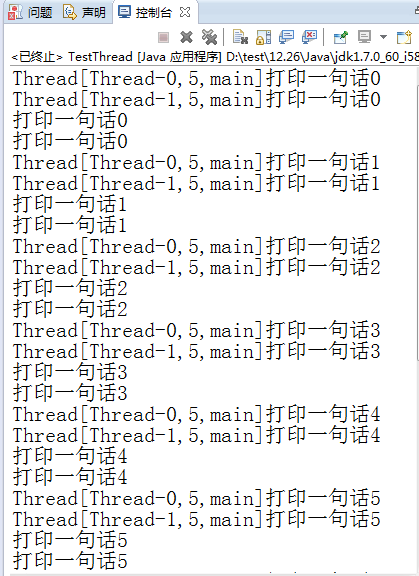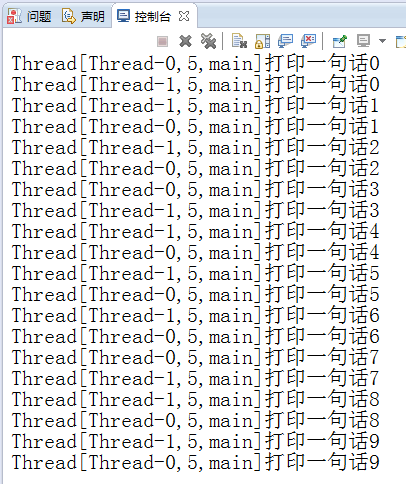1 /* 2 * 1,尝试定义一个继承Thread类的类,并覆盖run()方法, 3 * 在run()方法中每隔100毫秒打印一句话。*/ 4 package Stream; 5 //方法一 继承Thread 实现多线程 6 public class TestX extends Thread { 7 public void run () { 8 xiancheng();} 9 public void xiancheng() 10 { 11 for (int i = 0; i < 10; i++) { 12 System.out.println(this+"打印一句话"+i); 13 try { 14 Thread.sleep(100);//每100毫秒输出一次 15 } catch (InterruptedException e) { 16 // TODO 自动生成的 catch 块 17 e.printStackTrace(); 18 } 19 } 20 21 } 22 }
1 package Stream; 2 //方法二 实现Runnable 接口 3 public class TestXX implements Runnable { 4 5 @Override 6 public void run() { 7 duoxiancheng(); 8 } 9 public void duoxiancheng() { 10 for (int i = 0; i < 10; i++) { 11 System.out.println("打印一句话"+i); 12 try { 13 Thread.sleep(100); 14 } catch (InterruptedException e) { 15 // TODO 自动生成的 catch 块 16 e.printStackTrace(); 17 } 18 } 19 } 20 21 }
1 package Stream; 2 3 public class TestThread { 4 5 6 public static void main(String[] args) { 7 TestX i=new TestX(); 8 i.start(); 9 10 TestX ii=new TestX(); 11 ii.start(); 12 13 14 15 TestXX s=new TestXX(); 16 Thread hh= new Thread(s); 17 hh.start(); 18 19 TestXX ss=new TestXX(); 20 Thread hhs= new Thread(ss); 21 hhs.start(); 22 23 24 } 25 26 }



上述显示三图 分别为 图一 两种方式一起输出 太长没有全截取 图二 为通过集成Thread实现多线程 图三为通过应用Runnable接口实现多线程
多线程 笔记
①线程 进程里的执行流程
②实现方式 1,继承Thread 重写一个run()方法
使用start()方法启动多线程 同一时间只能
启动一个线程
2,实现Runnable接口 重写run()方法
调用Thread(Runnable)
调用Thread对象的start
③生命周期 出生状态
就绪状态
运行状态
等待状态
休眠状态
阻塞状态
死亡状态